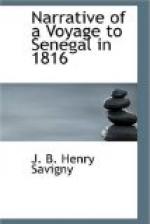This town has, in other respects, nothing very interesting in it, only the streets are strait, and pretty broad, the houses tolerably well built and airy. The soil is a burning sand, which produces but few vegetables: there are only eight or ten little gardens, containing from two to four ares of ground at the most, all cultivated, and in which, within these few years orange and lemon trees have been planted, so that there is reason to suppose, that, with some care, these trees would thrive perfectly well. Mr. Correard saw a fig-tree and an European vine, which are magnificent, and bear a large quantity of fruit. Since the colony has been restored to the French several kinds of fruit-trees have been planted, which thrive in an extraordinary manner. Five or six palatuviers, and a dozen palm trees are dispersed about the town.
The parade is tolerably handsome; it is situated opposite the castle, and what is called the fort and the barracks. On the west it is covered by a battery of ten or twelve twenty-four pounders, and two mortars; this is the principal strength of the island. On the east is the port, where vessels lie in great safety. The population of the town amounts to 10,000 souls, as the Mayor told Mr. Correard. The inhabitants of the island are both Catholics and Mahometans; but the latter are the most numerous, notwithstanding this, all the inhabitants live in peace and the most perfect harmony. There are no dissentions about religious opinions: every one prays to God in his own manner; but it is observed, that the men who have abjured Mahometanism, still retain the custom of having several wives. We think that it would not be very difficult to abolish it among the blacks, who are struck with the pomp of our religious ceremonies: they would be much more inclined to the Catholic religion, if it tolerated polygamy, a habit which will inevitably render all the efforts of the Missionaries abortive, as long as they commence their instruction by requiring its abolition.
The isle of St. Louis, by its important position, may command the whole river, being placed at the head of an Archipelago of pretty considerable islands: its extent is however small. Its length is 2,500 metres from north to south; and its breadth from east to west is, at the north part, 370 metres; in the middle of its length 28 metres; and at the south only 170 metres. The elevation of its soil is not more than 50 centimetres above the level of the river: in the middle it is however a little higher, which facilitates the running of the waters. The river dividing to form the isle of St. Louis has two arms, which reunite below the island: the principal situated on the east is about 1000 metres in breadth, and that on the west about 600. The currents are very rapid, and carry with them quantities of sand, which the sea throws back towards the coast; this it is that forms a bar at the mouth of the river; but the currents have opened themselves a passage,




